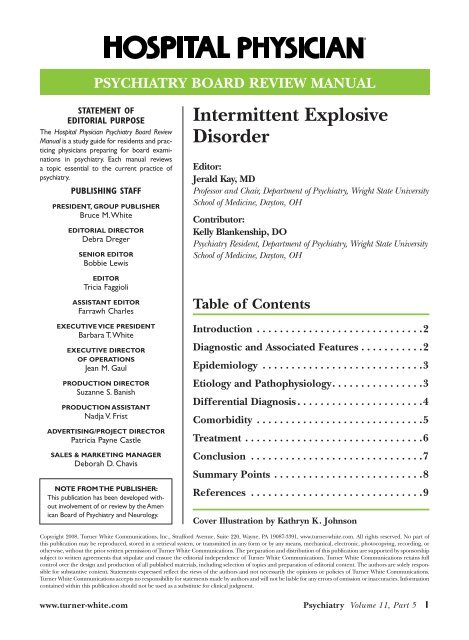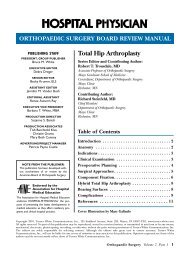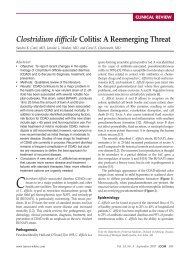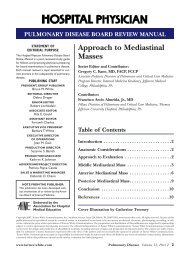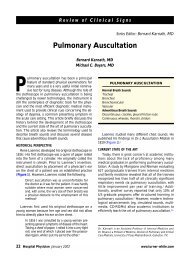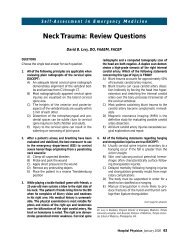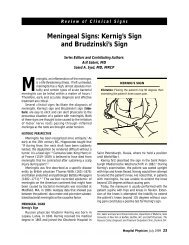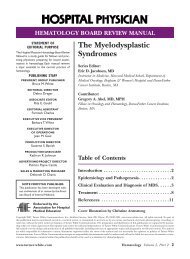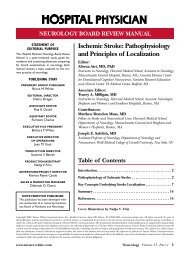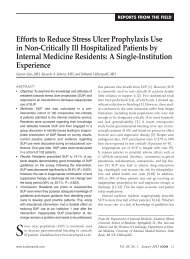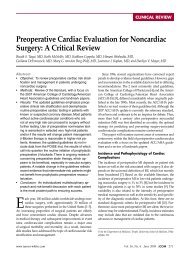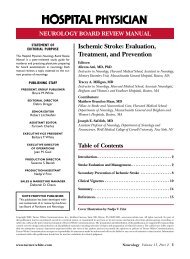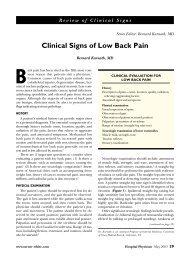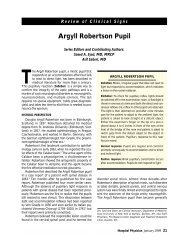Intermittent Explosive Disorder - Turner White
Intermittent Explosive Disorder - Turner White
Intermittent Explosive Disorder - Turner White
You also want an ePaper? Increase the reach of your titles
YUMPU automatically turns print PDFs into web optimized ePapers that Google loves.
®<br />
Psychiatry Board Review Manual<br />
Statement of<br />
Editorial Purpose<br />
The Hospital Physician Psychiatry Board Review<br />
Manual is a study guide for residents and practicing<br />
physicians preparing for board examinations<br />
in psychiatry. Each manual reviews<br />
a topic essential to the current practice of<br />
psychiatry.<br />
PUBLISHING STAFF<br />
PRESIDENT, Group PUBLISHER<br />
Bruce M. <strong>White</strong><br />
editorial director<br />
Debra Dreger<br />
SENIOR EDITOR<br />
Bobbie Lewis<br />
EDITOR<br />
Tricia Faggioli<br />
assistant EDITOR<br />
Farrawh Charles<br />
executive vice president<br />
Barbara T. <strong>White</strong><br />
executive director<br />
of operations<br />
Jean M. Gaul<br />
PRODUCTION Director<br />
Suzanne S. Banish<br />
PRODUCTION assistant<br />
Nadja V. Frist<br />
ADVERTISING/PROJECT Director<br />
Patricia Payne Castle<br />
sales & marketing manager<br />
Deborah D. Chavis<br />
NOTE FROM THE PUBLISHER:<br />
This publication has been developed without<br />
involvement of or review by the American<br />
Board of Psychiatry and Neurology.<br />
<strong>Intermittent</strong> <strong>Explosive</strong><br />
<strong>Disorder</strong><br />
Editor:<br />
Jerald Kay, MD<br />
Professor and Chair, Department of Psychiatry, Wright State University<br />
School of Medicine, Dayton, OH<br />
Contributor:<br />
Kelly Blankenship, DO<br />
Psychiatry Resident, Department of Psychiatry, Wright State University<br />
School of Medicine, Dayton, OH<br />
Table of Contents<br />
Introduction . . . . . . . . . . . . . . . . . . . . . . . . . . . . .2<br />
Diagnostic and Associated Features . . . . . . . . . . .2<br />
Epidemiology . . . . . . . . . . . . . . . . . . . . . . . . . . . .3<br />
Etiology and Pathophysiology . . . . . . . . . . . . . . . .3<br />
Differential Diagnosis . . . . . . . . . . . . . . . . . . . . . .4<br />
Comorbidity . . . . . . . . . . . . . . . . . . . . . . . . . . . . .5<br />
Treatment . . . . . . . . . . . . . . . . . . . . . . . . . . . . . . .6<br />
Conclusion . . . . . . . . . . . . . . . . . . . . . . . . . . . . . .7<br />
Summary Points . . . . . . . . . . . . . . . . . . . . . . . . . .8<br />
References . . . . . . . . . . . . . . . . . . . . . . . . . . . . . .9<br />
Cover Illustration by Kathryn K. Johnson<br />
Copyright 2008, <strong>Turner</strong> <strong>White</strong> Communications, Inc., Strafford Avenue, Suite 220, Wayne, PA 19087-3391, www.turner-white.com. All rights reserved. No part of<br />
this publication may be reproduced, stored in a retrieval system, or transmitted in any form or by any means, mechanical, electronic, photocopying, recording, or<br />
otherwise, without the prior written permission of <strong>Turner</strong> <strong>White</strong> Communications. The preparation and distribution of this publication are supported by sponsorship<br />
subject to written agreements that stipulate and ensure the editorial independence of <strong>Turner</strong> <strong>White</strong> Communications. <strong>Turner</strong> <strong>White</strong> Communications retains full<br />
control over the design and production of all published materials, including selection of topics and preparation of editorial content. The authors are solely responsible<br />
for substantive content. Statements expressed reflect the views of the authors and not necessarily the opinions or policies of <strong>Turner</strong> <strong>White</strong> Communications.<br />
<strong>Turner</strong> <strong>White</strong> Communications accepts no responsibility for statements made by authors and will not be liable for any errors of omission or inaccuracies. Information<br />
contained within this publication should not be used as a substitute for clinical judgment.<br />
www.turner-white.com<br />
Psychiatry Volume 11, Part 5
Psychiatry Board Review Manual<br />
<strong>Intermittent</strong> <strong>Explosive</strong> <strong>Disorder</strong><br />
Kelly Blankenship, DO<br />
INTRODUCTION<br />
<strong>Intermittent</strong> explosive disorder (IED) was once considered<br />
a rare disorder; however, recent studies have<br />
indicated that IED is much more prevalent than previously<br />
thought. 1 IED is associated with a high degree<br />
of social impairment. In a study of 253 individuals in<br />
a community sample diagnosed with IED, 81.3% reported<br />
psychosocial difficulties, 50% admitted to difficulties<br />
within their life due to their behavior, and 62.5%<br />
noted significant difficulties with relationships. 2 IED<br />
may lessen in intensity as individuals become older. 3<br />
Diagnosis is difficult, in part due to the vagueness of the<br />
DSM diagnostic criteria. 4 Further, the paucity of IED<br />
studies makes identifying and treating IED a challenge.<br />
Despite these limitations, physicians must assess these<br />
impulsive and aggressive patients and be aware of available<br />
treatment options for these individuals. 5<br />
DIAGNOSTIC AND ASSOCIATED FEATURES<br />
IED is characterized by short-lived episodes of impulsive<br />
aggression that are substantially out of proportion to<br />
the inciting stressor, resulting in destruction of property<br />
or serious assaultive acts. 6 IED is currently listed in the<br />
DSM-IV under impulse-control disorders not elsewhere<br />
classified. 6 Diagnostic criteria and the name of the disorder<br />
have changed over time. In DSM-I, IED was referred<br />
to as passive-aggressive personality, aggressive type, and<br />
in DSM-II, IED was termed explosive personality disorder.<br />
It was not until DSM-III that the term IED was used;<br />
however, the DSM-III criteria excluded patients with<br />
antisocial personality disorder 7 and generalized aggression<br />
or impulsivity, 1 and in the DSM-III-R, patients with<br />
borderline personality disorder were excluded. The<br />
DSM-IV criteria for diagnosing IED no longer excludes<br />
patients with impulsivity or generalized aggression 7 but<br />
includes the criterion that another mental disorder,<br />
substance abuse, or general medical condition must not<br />
better account for the aggressive acts (Table 1). 6 Impulsive<br />
aggression is not unique to IED and can be seen in<br />
multiple psychiatric and medical conditions. Thus, IED<br />
Hospital Physician Board Review Manual<br />
is a diagnosis of exclusion. 3 Of note, some studies use<br />
terms such as “episodic dyscontrol” or “rage attacks” to<br />
describe aggression, making it difficult to pinpoint how<br />
many patients meet the criteria for IED. 4 In addition,<br />
some doubt that IED is an actual diagnosis and believe<br />
that impulsive aggression is a symptom that can be experienced<br />
in multiple diseases. 8<br />
The aggressive episodes are often described by patients<br />
as “spells” or “attacks,” and the symptoms often<br />
appear and resolve in minutes to hours. Symptoms<br />
have been described as an “adrenaline rush” or “seeing<br />
red.” 1 As with other impulse-control disorders, there is<br />
often a feeling of release of tension after the episode.<br />
Aggression related to IED is often ego-dystonic and<br />
patients feel a sense of remorse and regret after the<br />
aggressive act. 3 In a study of 27 patients who met current<br />
or past DSM-IV criteria for IED, 33% complained<br />
of physical autonomic symptoms such as palpitations,<br />
tingling, and tremor prior to the episode, and 52%<br />
complained of a change in their level of awareness. 8<br />
In a study of 443 violent men, those who met<br />
DSM-III criteria for IED (n = 15) felt that an intimate<br />
partner would most likely provoke them. Their attacks<br />
usually occurred without warning, and all of the men<br />
denied wanting the outburst to occur prior to the episode.<br />
Men often attempted to console their victim after<br />
their rageful outburst. 9<br />
Impulsive aggression often has different motivations.<br />
If motivation includes monetary gain, vengeance, selfdefense,<br />
social dominance, expressing a political statement,<br />
or when it occurs as a part of gang behavior, IED<br />
should not be the diagnosis. 3 The impulsive aggression<br />
seen in IED is not the same as the willingly performed<br />
and thought out aggression often seen in criminal behavior.<br />
Thus, when behavior is premeditated, individuals<br />
should not be diagnosed with IED. 4<br />
Because DSM-IV exclusion criteria created difficulties<br />
in diagnosing IED, integrated research criteria<br />
(IED-IR) have been formed. A study that examined<br />
the convergent and discriminate validity of the IED-IR<br />
criteria found that IED-IR individuals who met DSM-IV<br />
diagnostic criteria for IED were no more aggressive or<br />
impaired than IED-IR individuals who did not meet<br />
these criteria. 4 In another attempt to clarify diagnostic<br />
www.turner-white.com
I n t e r m i t t e n t E x p l o s i v e D i s o r d e r<br />
criteria for IED, an interview module for IED (IED-M)<br />
was studied. The IED-M required a minimum number<br />
of aggressive acts (2 times/wk for 1 mo) and the events<br />
must be spontaneous, excessive, and have associated<br />
anguish. 5 A pilot study was performed to evaluate the<br />
validity of the IED-M in detecting IED in children. 10<br />
Olvera et al 10 provided preliminary data that the IED-M<br />
is useful for detecting IED in teenagers.<br />
EPIDEMIOLOGY<br />
As formulated in the DSM-IV-TR, IED is probably a<br />
rare disorder 3 ; however, recent data have indicated that<br />
this may not be true. In a chart review of 830 patients<br />
in 1983, only 1.1% were found to meet DSM-III criteria<br />
for IED. 11 In a second report of 433 aggressive participants,<br />
1.8% qualified for a diagnosis of IED by DSM-III<br />
standards. 7 A 2005 study of 1300 patients seeking mental<br />
health care found that 6.3% met DSM-IV criteria for<br />
lifetime IED and 3.1% met criteria for a current diagnosis<br />
of IED. 7 A face-to-face household survey of 9282<br />
individuals found a lifetime and 12-month incidence of<br />
IED of 7.3% and 3.9%, respectively. 1<br />
Most studies indicate onset of IED in adolescence.<br />
McElroy et al 8 found an average age of onset of 14 years,<br />
with the disease lasting an average of 20 years. Seventyfour<br />
percent of the participants were male. Kessler et al 1<br />
also found the average disease onset of age 14 years as<br />
well as an average of 43 attacks over an individual’s life<br />
with an average cost of $1359 for damaged objects per<br />
lifetime. In the study, injuries related to the disorder<br />
occurred 180 times for every 100 lifetime cases. Risk<br />
factors included male sex, young age, lower level of<br />
education, being married, employment, and having<br />
decreased revenue within the home. 1 Another study<br />
found that IED showed a linear pattern of occurrence<br />
from young to old and lower to higher education. 7<br />
Individuals who completed a college degree or beyond<br />
were 2 times less likely to meet criteria for IED than<br />
those who had a high school diploma and/or some<br />
college. Further, high school graduates were 2 times<br />
less likely to meet criteria for IED as those who did not<br />
graduate high school. IED was less common in whites<br />
as compared with nonwhites. 7<br />
ETIOLOGY AND PATHOPHYSIOLOGY<br />
www.turner-white.com<br />
Table 1. DSM-IV-TR Diagnostic Criteria for <strong>Intermittent</strong><br />
<strong>Explosive</strong> <strong>Disorder</strong><br />
A. Several discrete episodes of failure to resist aggressive impulses<br />
that result in serious assaultive acts or destruction of property<br />
B. The degree of aggressiveness expressed during the episodes<br />
is grossly out of proportion to any precipitating psychosocial<br />
stressors<br />
C. The aggressive episodes are not better accounted for by another<br />
mental disorder (eg, antisocial personality disorder, borderline<br />
personality disorder, psychotic disorder, manic episode, conduct<br />
disorder, attention-deficit/hyperactivity disorder) and are not<br />
due to the direct physiologic effects of a substance (eg, a drug<br />
of abuse, a medication) or a general medical condition (eg, head<br />
trauma, Alzheimer’s disease)<br />
Adapted with permission from American Psychiatric Association. Diagnostic<br />
and statistical manual of mental disorders. 4th ed., text revision.<br />
Washington (DC): The Association; 2000:667. Copyright 2000, American<br />
Psychiatric Association.<br />
At one time, theories regarding impulsive aggression<br />
included possession by spirits, humeral imbalances, and<br />
moral weakness. As psychiatry advanced, so did its theories<br />
on impulsive aggression. In the latter part of the<br />
19th century, 2 main theories evolved: (1) impulsive aggression<br />
was, at least in part, due to events experienced<br />
in youth and (2) impulsive aggression was the result of<br />
differences in brain chemistry and makeup. 3<br />
In studies involving rhesus monkeys, researchers<br />
found that disrupting early attachment to parental<br />
figures was a risk factor for becoming aggressive at<br />
improper times. 12 In a human study that measured<br />
gender differences in proactive and reactive aggression,<br />
proactive aggression was associated with poor<br />
parenting in both sexes, and reactive aggression was<br />
associated with traumatic experiences at a young age in<br />
females. 13 In monkey studies, female monkeys isolated<br />
from their mother immediately and other monkeys<br />
for the initial 18 months of their life showed deficits in<br />
childrearing, being more indifferent and angry toward<br />
their offspring. 12 From a social learning perspective,<br />
there is an expectation that children learn to parent<br />
from interactions with their own parents. In a study<br />
designed to examine the continuities in aggressive<br />
parenting and behavior in their offspring, persons exposed<br />
to aggressive parenting as children were likely<br />
to parent aggressively as adults. It was also found that<br />
childrearing also had a direct impact on behavior and<br />
relationships experienced as young adults and teenagers.<br />
14 Evidence has suggested that IED is familial and<br />
individuals with a family history of IED have an elevated<br />
risk for the disorder. 15<br />
Decreased levels of serotonin activity, as measured<br />
by cerebrospinal fluid (CSF) concentrations of<br />
5-hydroxyindoleacetic acid (5-HIAA), have been observed<br />
in studies of both humans and monkeys with<br />
Psychiatry Volume 11, Part 5
I n t e r m i t t e n t E x p l o s i v e D i s o r d e r<br />
Table 2. Psychiatric <strong>Disorder</strong>s That Present with Impulsive Aggression<br />
Mental <strong>Disorder</strong><br />
Features<br />
Antisocial personality disorder<br />
Borderline personality disorder<br />
Conduct disorder<br />
Dementia with behavioral disturbance<br />
Personality change caused by a general<br />
medical condition, aggressive type 6<br />
Pervasive pattern of disregard for and violation of the rights of others; symptoms may include irritability<br />
and aggressiveness (eg, repeated physical fights and assaults) 6<br />
Pervasive pattern of instability of relationships, self-image, and affects, and marked impulsivity; symptoms<br />
may include inappropriate, intense anger or difficulty controlling anger (eg, frequent displays of temper,<br />
constant anger, recurrent physical fights) 6<br />
Repetitive and persistent pattern of behavior in which basic rights of others or societal norms and rules<br />
are violated; symptoms may include aggression towards people and animals (eg, bullies/threatens others,<br />
initiates physical fights) or destruction of property 6<br />
Aggression is a common behavioral symptom of dementia. Patients with dementia can become<br />
combative with staff or loved ones who attempt to help them with their personal care 19<br />
Aggression can be caused by multiple neurologic conditions<br />
Posttraumatic stress disorder (PTSD) Although aggression is not included in the diagnostic criteria for PTSD, it is a recognized characteristic 20<br />
impulsive aggression. It has been suggested that decreased<br />
serotonin in CSF concentrations can lead to the<br />
inability to constrain the impulse that causes “offensive<br />
aggression.” This is supported by studies in which monkeys<br />
with decreased CSF serotonin exhibit “risky” behavior.<br />
12 Adolescent male rhesus macaques with low CSF<br />
concentrations showed high levels of aggression and<br />
were at greater risk of death at a young age due to aggression.<br />
16 In rodent studies, there was a noted increase<br />
in aggression with decreased brain serotonin as well as<br />
increased killing among the rodents with low serotonin.<br />
The more aggressive impulses were also seen when serotonergic<br />
neurons were depleted. However, when serotonin<br />
in the brain was replaced, aggression remitted. In<br />
a study comparing murderers with suicide attempters,<br />
suicide attempters had decreased levels of CSF 5-HIAA,<br />
whereas the murderers did not. 16 However, murderers<br />
who killed their sexual partners had extreme low levels<br />
of CSF 5-HIAA. The authors assumed the murders were<br />
performed during times of high affective response and<br />
concluded that serotonin abnormalities are seen in<br />
violence “in states of emotional turmoil.” 16 Aggression<br />
in adults and adolescents after puberty has been seen in<br />
individuals with increased testosterone levels. 5<br />
Specific areas of the brain, including the prefrontal<br />
cortex and the amygdala, have been suspected to be associated<br />
with impulsive aggression. 5 Increased aggressive<br />
behavior has been seen in individuals with lesions in the<br />
frontal or temporal lobes. 17 Impulsivity can be seen in<br />
damage to the frontal lobe. In a study using functional<br />
magnetic resonance imaging to examine response inhibition,<br />
more impulsive individuals activated paralimbic<br />
areas, particularly the right inferior frontal gyrus<br />
extending to the posterior lateral orbitofrontal cortex<br />
and anterior insula, whereas less impulsive individuals<br />
activated higher order association areas when inhibiting<br />
a prepotent response. 18 Other studies have shown that<br />
areas of the prefrontal cortex can be involved in impulsive<br />
aggression, and brain positron emission tomography<br />
has demonstrated a decreased glucose metabolism in<br />
prefrontal and frontal cortex in these patients. 3<br />
DIFFERENTIAL DIAGNOSIS<br />
A medical work-up should be performed before a<br />
diagnosis of IED is given. If the patient has a history<br />
of memory loss, head trauma, or seizures, a neurology<br />
consult may be considered. Imaging studies and<br />
electroencephalography (EEG) may also be helpful. 5<br />
There are many neurologic disorders that can cause aggressiveness,<br />
including brain abscesses, dementia, partial<br />
complex seizures, encephalitis, frontal focal lesions,<br />
and cerebrovascular accident. In these neurologic conditions,<br />
personality change due to a general medical<br />
condition, aggressive type is the correct diagnosis. 3<br />
In patients with IED, physical examination may reveal<br />
nonspecific soft neurologic signs, such as minor<br />
difficulties in hand-eye coordination or small reflex<br />
asymmetries. 3 There may also be hypersensitivity to sensory<br />
stimuli or abnormalities on EEG. 11 In individuals<br />
with anger that occurs suddenly, slowing may be seen<br />
throughout the EEG. 3<br />
IED is a diagnosis of exclusion, and, as such, other<br />
psychiatric diagnoses must first be ruled out (Table 2). Because<br />
many psychiatric disorders can present with a history<br />
of impulsive aggression, distinguishing IED from other<br />
psychiatric disorders can be difficult. Antisocial personality<br />
disorder, borderline personality disorder, conduct disorder,<br />
dementia with behavioral disturbance, oppositional<br />
Hospital Physician Board Review Manual<br />
www.turner-white.com
I n t e r m i t t e n t E x p l o s i v e D i s o r d e r<br />
Table 3. Lifetime <strong>Intermittent</strong> <strong>Explosive</strong> <strong>Disorder</strong> (IED) Diagnosis and Other Comorbid Axis I Diagnoses<br />
Study<br />
Patients with IED<br />
and Other Impulse-<br />
Control <strong>Disorder</strong>s, %<br />
Patients with IED<br />
and ≥ 1 DSM-IV<br />
Axis I Diagnosis, %<br />
Patients with<br />
IED and Anxiety<br />
<strong>Disorder</strong>, %<br />
Patients with<br />
IED and Mood<br />
<strong>Disorder</strong>, %<br />
Patients with IED<br />
and Substance Use<br />
<strong>Disorder</strong>, %<br />
Kessler et al 1 * 44.9 81.8 58.1 37.4 35.1<br />
Coccaro et al 7 7.3 — 78 75.6 59.8<br />
McElroy et al 8 44 96 48 93 48<br />
*Statistics used were for broadly defined lifetime IED.<br />
defiant disorder, personality change caused by a general<br />
medical condition, aggressive type, and posttraumatic<br />
stress disorder (PTSD) all involve aggression. 5 A diagnosis<br />
of IED should be considered only after other diagnoses<br />
for impulsive aggression have been invalidated. 3<br />
When distinguishing IED from personality disorders,<br />
it is often helpful to consider baseline behavior. Aggressive<br />
behavior demonstrated on a normal daily basis is<br />
in stark contrast to the discrete episodes of impulsive<br />
aggressiveness seen in IED. 3 In children, symptoms of<br />
bipolar disorder and IED can be similar. 21<br />
The inappropriate expression of anger is a key feature<br />
in borderline personality disorder. 22 Patients with<br />
borderline personality disorder or antisocial personality<br />
disorder often describe a history of lifetime of continuance<br />
impulsive aggression instead of discrete episodes<br />
of aggression. 3 Aggression (physical, verbal, or sexual)<br />
is commonly seen in older individuals with dementia.<br />
The physical aggression seen in this disease process<br />
is often the prompt that leads to nursing home placement.<br />
19 Aggression may also be seen if individuals are<br />
under the influence or withdrawing from a substance.<br />
IED would not be diagnosed in either circumstance. 23<br />
A study addressing anger and aggression in outpatient<br />
psychiatric patients found that generalized anxiety<br />
disorder and drug abuse/dependence were linked to<br />
higher rates of aggression. IED, bipolar I disorder, and<br />
PTSD were most likely to be linked with current aggressive<br />
behavior. 24 Although aggression is not officially<br />
recognized as a characteristic of PTSD, new evidence<br />
is emerging to support that aggression does occur in<br />
PTSD. Fifty couples in which the male was a Vietnam<br />
veteran were questioned. All of the men exhibited<br />
PTSD symptoms. The survey found that 100% of these<br />
men participated in psychological aggression against<br />
their mate, 92% engaged in verbal aggression, and 34%<br />
had 1 or more episodes of physical aggression. 20<br />
Another type of aggression, anger attacks, may be<br />
seen in depressed patients and usually occur when a<br />
person feels emotionally trapped and experiences outbursts<br />
of anger. These attacks may include irritability,<br />
www.turner-white.com<br />
autonomic symptoms, and exaggerated reaction to a<br />
small irritant with rage. Three studies indicated that in<br />
patients with major depression, anger attacks were seen<br />
between 38% and 44% of the time. Studies indicate<br />
that 30% to 40% of patients with any type of depression<br />
have anger attacks. 25<br />
COMORBIDITY<br />
Studies have indicated that most individuals with<br />
IED have a least 1 other lifetime DSM-IV diagnosis<br />
(Table 3). 1,7,8 In a report of 27 cases of IED, 26 (96%)<br />
met requirements for at least 1 other DSM-IV Axis I diagnosis,<br />
and 19 (70%) patients met criteria for 3 or more<br />
diagnoses. 8 Of the 27 patients, 25 (93%) met criteria for<br />
a mood disorder during their lifetime, and 14 (52%)<br />
met lifetime criteria for bipolar disorder. Thirteen patients<br />
were diagnosed with a type of anxiety disorder,<br />
13 were diagnosed with a substance abuse/dependence<br />
disorder, 6 were diagnosed with eating disorders, and<br />
12 had other impulse-control disorders. 8 Five patients<br />
reported a diagnosis of attention-deficit/hyperactivity<br />
disorder as a child. Some participants with mood and<br />
substance use disorders reported changes in their IED<br />
symptoms with changes in mood or substance use. Six<br />
participants noted worsening IED symptoms during<br />
depression, while 5 noted a worsening of IED during<br />
mania. Of the 7 women included in the study, 5 noted<br />
that IED worsened during their premenstrual period.<br />
All individuals with substance use disorders reported<br />
differences in IED symptomatology with substance use;<br />
7 patients noted an increase in IED symptoms with alcohol<br />
use whereas 2 noted a decrease, and 5 individuals<br />
stated that marijuana decreased their IED symptoms.<br />
Incidence of headache in the sample was high, with 12<br />
of the participants reporting migraines. 8<br />
Coccaro et al 7 studied 1300 patients requesting outpatient<br />
treatment and found that in addition to meeting<br />
criteria for IED, 75.6 % also met criteria for a lifetime<br />
mood disorder, 32.7% met criteria for personality<br />
Psychiatry Volume 11, Part 5
I n t e r m i t t e n t E x p l o s i v e D i s o r d e r<br />
disorders, 59.8% met criteria for a substance use disorder,<br />
and 78% met criteria for anxiety disorders. The<br />
National Comorbidity Survey Replication found that<br />
81.8% of individuals with lifetime broad IED also had<br />
at least 1 or more other lifetime DSM-IV diagnosis. 1 In<br />
this study, the odds ratios of IED with impulse-control<br />
and substance use disorders were not higher than those<br />
with mood and anxiety disorders. Based on these data,<br />
the author proposed that IED may be as much related<br />
to affective instability and dysregulation as to problems<br />
with impulse control. This study also found that IED<br />
had an earlier age of onset than most comorbidities,<br />
suggesting that IED could be a “risk factor” for diseases<br />
such as major depression, generalized anxiety disorder,<br />
panic disorder, and substance abuse disorders. However,<br />
there are no published data to confirm this suspicion.<br />
1 There is also some speculation that IED is also<br />
associated with bipolar disorder, as many individuals<br />
who meet criteria for IED also have a lifetime diagnosis<br />
of bipolar disorder. 4<br />
TREATMENT<br />
There are few studies evaluating treatment for IED. 5<br />
Further, the U.S. Food and Drug Administration has<br />
not approved any medications for the treatment of aggression.<br />
24 The National Comorbidity Survey Replication<br />
indicated that individuals who sought treatment<br />
for IED often waited until well after their first episode,<br />
and when they did seek treatment, it was commonly for<br />
another comorbid condition. 1 Many people with IED<br />
will eventually seek mental health treatment but not<br />
for their anger episodes. It could be that many patients<br />
may not feel that anger is a reason to seek psychiatric<br />
treatment. 1 One study found that only 20% of individuals<br />
with IED who sought treatment described IED as the<br />
reason for mental health treatment. 7<br />
PHARMACOLOGIC THERAPY<br />
Although there is a paucity of studies defining<br />
treatment for IED, McElroy 26 published an algorithm<br />
for treating angry or combative individuals (Figure).<br />
According to this algorithm, patients with unipolar depression<br />
should be started on a serotonin reuptake inhibitor,<br />
other antidepressants, or lamotrigine, whereas<br />
those with bipolar depression with a history of mania<br />
or mixed episodes should be treated with a mood<br />
stabilizer, antipsychotics, other antiepileptics, or antiandrogens.<br />
If there is no affective component, it should<br />
be determined whether the individual presented with<br />
compulsive or impulsive primary symptomatology. If<br />
the patient complains of compulsivity, selective serotonin<br />
reuptake inhibitors (SSRIs) or other serotonin<br />
agents are used. If the patient complains of impulsivity,<br />
SSRIs, other antidepressants, mood stabilizers, antiepileptics,<br />
β blockers, stimulants, or antiandrogens should<br />
be prescribed. 26 In a study of 27 patients with IED, 20<br />
received treatment with either a mood stabilizer or<br />
SSRI. At least a moderate response to medication was<br />
described by 60% of the individuals. 8<br />
Lithium has been found to be effective in decreasing<br />
aggression in several studies in differing patient populations.<br />
In a study involving 66 young nonpsychotic adult<br />
and adolescent prisoners (age range, 16–24 yr), lithium<br />
was superior to placebo in demonstrating reduced aggressive<br />
episodes. 27 In a 6-week, double-blind, placebocontrolled<br />
study of adolescents with conduct disorder,<br />
patients taking lithium demonstrated reduced aggression<br />
compared with those taking placebo. 28<br />
Improvements in aggression have been seen in<br />
adolescent males with the addition of valproic acid. In<br />
a placebo-crossover, double-blind, parallel-group study<br />
of 20 teens diagnosed with oppositional defiant disorder<br />
or conduct disorder and problematic temper and<br />
mood liability, valproic acid was superior to placebo in<br />
demonstrating reduced aggression. 29<br />
Several studies have shown that carbamazepine lessens<br />
aggression in multiple psychiatric disorders. Two open<br />
studies performed by Mattes 30 and Mattes et al 31 found<br />
that carbamazepine lessened aggression in rageful patients.<br />
Both studies included patients with multiple diagnoses;<br />
12 of 28 and 19 of 34 patients, respectively, had<br />
been diagnosed with IED. In a randomized, double-blind<br />
study by Neppe, 32 aggression was 1.5 times less common<br />
when treated with carbamazepine compared with placebo.<br />
These individuals were chronic psychiatric hospitalized<br />
inpatients who did not have epilepsy but had abnormal<br />
temporal lobe findings on EEG. 32 Phenytoin has<br />
also been shown to decrease impulsive aggression. In a<br />
double-blind, placebo-controlled, crossover study performed<br />
on 60 inmates, the inmates with impulsive aggression<br />
had reductions in aggressive behavior. 33<br />
In a study of impulsive aggression in 40 patients with<br />
a personality disorder, patients treated with fluoxetine<br />
showed a significant reduction in aggressive symptoms<br />
compared with the placebo group, as measured by the<br />
Overt Aggression Scale Modified for Outpatients. 34 All<br />
40 participants in this study were found to fulfill IED research<br />
criteria. 15 SSRIs may take approximately 3 months<br />
to reach full benefit in patients with IED; thus, a sufficient<br />
trial of an SSRI should include at least 3 months.<br />
Symptoms also tend to reappear shortly after the medication<br />
is discontinued. 15<br />
Hospital Physician Board Review Manual<br />
www.turner-white.com
I n t e r m i t t e n t E x p l o s i v e D i s o r d e r<br />
Depressive/unipolar<br />
SRIs<br />
Other antidepressants<br />
Lamotrigine<br />
Is there an affective<br />
component?<br />
Affective symptoms/<br />
syndrome<br />
Manic or mixed/bipolar<br />
Mood stabilizers (eg, divalproex,<br />
lithium, carbamazepine)<br />
Antipsychotics (typical and atypical)<br />
Other antiepileptics (eg, gabapentin,<br />
phenytoin)<br />
Antiandrogens<br />
Combinations<br />
Compulsive<br />
SRIs<br />
5-HT agents<br />
Combinations<br />
No affective symptoms/<br />
syndrome<br />
Impulsive<br />
SRIs<br />
Other antidepressants<br />
Mood stabilizers<br />
Antiepileptics<br />
b Blockers<br />
Stimulants<br />
Antiandrogens<br />
Combinations<br />
Figure. Algorithm for treating agitation and violence. SRI = serotonin reuptake inhibitor. (Reprinted with permission from McElroy SL.<br />
Recognition and treatment of DSM-IV intermittent explosive disorder. J Clin Psychiatry 1999;60 Suppl 15:12–6. Copyright © 1999, Physicians<br />
Postgraduate Press.)<br />
β Blockers may also be used to treat aggression in<br />
some patients, but they have worrisome side effects,<br />
such as bradycardia, dizziness, and hypotension, and the<br />
appropriate dose is difficult to determine. 15,35 Studies<br />
evaluating pindolol in brain damaged patients showed a<br />
lessening of aggression in these patients. 5 Another study<br />
demonstrated a lessening of aggression in adolescents<br />
who were given α 2<br />
agonists. 36 However, their use in this<br />
setting has been questioned due to reports of sudden<br />
death in young patients taking α 2<br />
agonists with other<br />
drugs. The side effects include worsening depression,<br />
sedation, and decreased blood pressure. 5<br />
Recent studies have shown atypical antipsychotics to<br />
be effective in treating aggression. 37,38 Atypical antipsychotics<br />
have a preferred side effect profile compared<br />
with typical antipsychotics. 5<br />
NONPHARMACOLOGIC THERAPY<br />
Cognitive behavioral therapy has been shown to decrease<br />
anger and aggression in individuals with anger<br />
problems. These trials were not specific to IED patients;<br />
thus, more studies are needed to confirm the effectiveness<br />
of cognitive behavioral therapy in patients with<br />
IED. 15 In a small sample (n = 4) of patients who received<br />
insight-oriented or supportive psychotherapy when exhibiting<br />
IED signs, 3 of 4 found that it was useful for<br />
constraining their impulsive aggression. All 4 patients<br />
receiving family, couples, or group therapy reported no<br />
reduction in aggressive behavior with therapy. 8<br />
CONCLUSION<br />
IED is characterized by impulsive aggression occurring<br />
in discrete episodes. Impulsive aggression is seen<br />
in multiple conditions; thus, IED is a diagnosis of exclusion,<br />
and other conditions in which aggression is seen<br />
should first be ruled out before IED is diagnosed. IED<br />
also occurs in association with other psychiatric disorders,<br />
adding to the difficulty in making an appropriate<br />
diagnosis. Although the etiology is uncertain, IED has<br />
been hypothesized to originate as a result of either<br />
childhood events or alterations in brain chemistry,<br />
particularly alterations in serotonin. 3 Age of onset is<br />
www.turner-white.com<br />
Psychiatry Volume 11, Part 5
I n t e r m i t t e n t E x p l o s i v e D i s o r d e r<br />
adolescence, and risk factors include male sex, young<br />
age, being married, a decreased household income,<br />
and a high degree of social impairment. Studies evaluating<br />
IED are sparse, and studies evaluating treatments<br />
for IED are even more so. Currently, there are no drugs<br />
approved for the treatment of aggression; however, studies<br />
have demonstrated decreased aggression in certain<br />
populations with the use of pharmacologic agents, such<br />
as lithium, atypical antipsychotics, valproic acid, phenytoin,<br />
SSRIs, and β blockers, and psychotherapy.<br />
SUMMARY POINTS<br />
• Recent studies have indicated that IED is much more<br />
prevalent than previously thought; a recent study of<br />
9282 individuals found an incidence of 7.3% for lifetime<br />
diagnosis of IED and 3.9% 12-month incidence<br />
rate.<br />
• Diagnosis of IED can be difficult due to vagueness of<br />
the diagnostic criteria and the frequency of impulsive<br />
aggression seen in other illnesses.<br />
• When diagnosing IED, it is important to remember<br />
that the episodes of rage are short and substantially<br />
out of proportion to the stressor causing the event,<br />
and the episodes result in property damage or assault<br />
of individuals.<br />
• IED is a diagnosis of exclusion; thus, all other causes<br />
of rage and outbursts must be excluded before giving<br />
this diagnosis. Other diagnoses that can mimic<br />
IED include neurologic disorders, antisocial personality<br />
disorder, borderline personality disorder,<br />
conduct disorder, dementia with behavioral disturbance,<br />
oppositional defiant disorder, and PTSD.<br />
• Aggression of different forms is very common when<br />
patients are withdrawing or under the influence of<br />
different substances. These individuals should not<br />
be diagnosed with IED.<br />
• Patients with IED are at risk for high impairment in<br />
multiple aspects of their life. Many report difficulties<br />
psychosocially, and individuals with IED often have<br />
difficulties with significant relationships throughout<br />
their life.<br />
• The intensity of IED tends to lessen as the patient<br />
becomes older.<br />
• IED-related behavior is not the same as well-planned<br />
criminal behavior. If the behavior is premeditated,<br />
individuals should not be given a diagnosis of IED.<br />
• Although the average age of onset of IED appears<br />
to be in adolescence, most patients do not seek<br />
treatment until they are much older. The reason for<br />
seeking treatment is most often another psychiatric<br />
condition they have comorbidly.<br />
• Most patients with IED have at least 1 other lifetime<br />
DSM-IV diagnosis. It is common for individuals with<br />
this disorder to met criteria for 3 or more diagnoses.<br />
Mood and anxiety disorders are often seen comorbidly<br />
in patients with IED.<br />
• Risk factors for IED include male sex, young age,<br />
low level of education, marriage, employment, and<br />
having decreased revenue in the home.<br />
• IED is thought to arise as a result of experiences<br />
from youth and differences in brain chemistry. Early<br />
disruption of attachment to a primary caregiver or<br />
aggressive parenting has been shown to be risk factors<br />
for aggressive behaviors as adults. A decreased<br />
level of serotonin activity in the CSF has been seen<br />
in aggressive individuals.<br />
• Studies have indicated that certain areas of the<br />
brain, including the prefrontal cortex and amygdala,<br />
are involved in aggression. Individuals with<br />
lesions in the frontal or temporal lobe have been<br />
shown to have increased aggression.<br />
• According to McElroy, violent individuals with unipolar<br />
depression should be started on a serotonin reuptake<br />
inhibitor, another antidepressant, or lamotrigine.<br />
Individuals with bipolar depression and a history of<br />
mania should be treated with a mood stabilizer, antipsychotics,<br />
other antiepileptics, or antiandrogens.<br />
• If no affective component is present, patients should<br />
be evaluated for compulsive verses impulsive primary<br />
symptomatology. If the patient has compulsive<br />
symptoms, SSRIs or other sertonin agents are<br />
indicated. If the patient has impulsivity symptoms,<br />
SSRIs, other antidepressants, mood stabilizers, antiepileptics,<br />
β blockers, stimulants, or antiandrogens<br />
are indicated.<br />
• In certain populations, studies have indicated that<br />
pharmacologic treatments, such as lithium, valproic<br />
acid, carbamazepine, phenytoin, fluoxetine, or atypical<br />
antipsychotics, are more effective than placebo<br />
in treating aggression.<br />
• Nonpharmacologic therapy, such as cognitive behavioral<br />
therapy, can help decrease anger episodes<br />
in patients with anger problems. A small study<br />
indicated that insight-oriented and supportive psychotherapy<br />
was helpful in controlling aggression in<br />
some patients when exhibiting signs of IED.<br />
Hospital Physician Board Review Manual<br />
www.turner-white.com
I n t e r m i t t e n t E x p l o s i v e D i s o r d e r<br />
REFERENCES<br />
1. Kessler RC, Coccaro EF, Fava M, et al. The prevalence<br />
and correlates of DSM-IV intermittent explosive disorder<br />
in the National Comorbidity Survey Replication. Arch<br />
Gen Psychiatry 2006;63:669–78.<br />
2. Coccaro EF, Schmidt CA, Samuels JF, Nestadt G. Lifetime<br />
and 1-month prevalence rates of intermittent explosive<br />
disorder in a community sample. J Clin Psychiatry 2004;<br />
65:820–4.<br />
3. Tasman A, Kay J, Lieberman JA. Psychiatry. 2nd ed.<br />
Hoboken (NJ): Wiley; 2003.<br />
4. McCloskey MS, Berman ME, Noblett KL, Coccaro EF.<br />
<strong>Intermittent</strong> explosive disorder-integrated research diagnostic<br />
criteria: convergent and discriminant validity.<br />
J Psychiatr Res 2006;40:231–42.<br />
5. Olvera RL. <strong>Intermittent</strong> explosive disorder: epidemiology,<br />
diagnosis and management. CNS Drugs 2002;16:<br />
517–26.<br />
6. American Psychiatric Association. Diagnostic and statistical<br />
manual of mental disorders: DSM-IV-TR. 4th ed.,<br />
text revision. Washington (DC): American Psychiatric<br />
Association; 2000.<br />
7. Coccaro EF, Posternak MA, Zimmerman M. Prevalence<br />
and features of intermittent explosive disorder in a clinical<br />
setting. J Clin Psychiatry 2005;66:1221–7.<br />
8. McElroy SL, Soutullo CA, Beckman DA, et al. DSM-IV intermittent<br />
explosive disorder: a report of 27 cases. J Clin<br />
Psychiatry 1998;59:203–11.<br />
9. Felthous AR, Bryant SG, Wingerter CB, Barratt E. The<br />
diagnosis of intermittent explosive disorder in violent<br />
men. Bull Am Acad Psychiatry Law 1991;19:71–9.<br />
10. Olvera RL, Pliszka SR, Konyecsni WM, et al. Validation<br />
of the Interview Module for <strong>Intermittent</strong> <strong>Explosive</strong> <strong>Disorder</strong><br />
(M-IED) in children and adolescents: a pilot study.<br />
Psychiatry Res 2001;101:259–67.<br />
11. Monopolis S, Lion JR. Problems in the diagnosis of intermittent<br />
explosive disorder. Am J Pyschiatry 1983;140:<br />
1200–2.<br />
12. Kalin NH. Primate models to understand human aggression.<br />
J Clin Psychiatry 1999;60 Suppl 15:29–32.<br />
13. Connor DF, Steingard RJ, Anderson JJ, Melloni RH Jr.<br />
Gender differences in reactive and proactive aggression.<br />
Child Psychiatry Hum Dev 2003;33:279–94.<br />
14. Conger RD, Neppl T, Kim KJ, Scaramella L. Angry and<br />
aggressive behavior across three generations: a prospective,<br />
longitudinal study of parents and children. J Abnorm<br />
Child Psychol 2003;31:143–60.<br />
15. Coccaro EF. <strong>Intermittent</strong> explosive disorder: taming temper<br />
tantrums in the volatile, impulsive adult. Curr Psychiatry<br />
Online 2003;2:1–10.<br />
www.turner-white.com<br />
16. Krakowski M. Violence and serotonin: influence of impulse<br />
control, affect regulation, and social functioning.<br />
J Neuropsychiatry Clin Neurosci 2003;15:294–305.<br />
17. Haller J, Kruk MR. Normal and abnormal aggression:<br />
human disorders and novel laboratory models. Neurosci<br />
Biobehav Rev 2006;30:292–303.<br />
18. Horn NR, Dolan M, Elliott R, et al. Response inhibition<br />
and impulsivity: an fMRI study. Neuropsychologia<br />
2003;41:1959–66.<br />
19. Raskind MA. Evaluation and management of aggressive<br />
behavior in the elderly demented patient. J Clin Psychiatry<br />
1999;60:Suppl 15:45–9.<br />
20. Yehuda R. Managing anger and aggression in patients<br />
with posttraumatic stress disorder. J Clin Psychiatry 1999;<br />
60 Suppl 15:33–7.<br />
21. Davanzo P, Yue K, Thomas MA, et al. Proton magnetic<br />
resonance spectroscopy of bipolar disorder versus intermittent<br />
explosive disorder in children and adolescents.<br />
Am J Psychiatry 2003;160:1442–52.<br />
22. Hollander E. Managing aggressive behavior in patients<br />
with obsessive-compulsive disorder and borderline personality<br />
disorder. J Clin Psychiatry 1999;60 Suppl 15:<br />
38–44.<br />
23. Stern TA, Herman JB, editors. Psychiatry update and<br />
board preparation. New York: McGraw-Hill; 2000.<br />
24. Posternak MA, Zimmerman M. Anger and aggression<br />
in psychiatric outpatients. J Clin Psychiatry 2002;63:<br />
665–72.<br />
25. Fava M, Rosenbaum JF. Anger attacks in patients with<br />
depression. J Clin Psychiatry 1999;60 Suppl 15:21–4.<br />
26. McElroy SL. Recognition and treatment of DSM-IV intermittent<br />
explosive disorder. J Clin Psychiatry 1999;60<br />
Suppl 15:12–6.<br />
27. Sheard MH, Marini JL, Bridges CI, Wagner E. The effect<br />
of lithium on impulsive aggressive behavior in men. Am<br />
J Psychiatry 1976;133:1409–13.<br />
28. Malone RP, Delaney MA, Luebbert JF, et al. A doubleblind<br />
placebo-controlled study of lithium in hospitalized<br />
aggressive children and adolescents with conduct disorder.<br />
Arch Gen Psychiatry 2000;57:649–54.<br />
29. Donovan SJ, Stewart JW, Nunes EV, et al. Divalproex<br />
treatment for youth with explosive temper and mood<br />
lability: a double-blind, placebo-controlled crossover design<br />
[published erratum appears in Am J Psychiatry 2000;<br />
157:1038]. Am J Psychiatry 2000;157:818–20.<br />
30. Mattes JA. Carbamezapine for uncontrolled rage outbursts.<br />
Lancet 1984;2:1164–5.<br />
31. Mattes JA, Rosenberg J, Mays D. Carbamazepine versus<br />
propranolol in patients with uncontrolled rage outbursts:<br />
a random assignment study. Psychopharmacol<br />
Bull 1984;20:98–100.<br />
32. Neppe VM. Carbamazepine as adjunctive treatment in<br />
non-epileptic chronic inpatients with EEG temporal<br />
lobe abnormalities. J Clin Psychiatry 1983;44:326–31.<br />
Psychiatry Volume 11, Part 5
I n t e r m i t t e n t E x p l o s i v e D i s o r d e r<br />
33. Barratt ES, Stanford MS, Felthous A, Kent TA. The effects<br />
of phenytoin on impulsive and premeditated aggression:<br />
a controlled study. J Clin Psychopharmacol 1997;<br />
17:341–9.<br />
34. Coccaro EF, Kavoussi RJ. Fluoxetine and impulsive aggressive<br />
behavior in personality disordered subjects. Arch<br />
Gen Psychiatry 1997;54:1081–8.<br />
35. Sadock BJ, Sadock VA. Kaplan & Sadock’s synopsis of<br />
psychiatry: behavioral sciences/clinical psychiatry. 9th ed.<br />
Philadelphia: Lippincott Williams & Wilkins; 2003.<br />
36. Kemph JP, DeVane CL, Levin GM, et al. Treatment of aggressive<br />
children with clonidine: results of an open pilot<br />
study. J Am Acad Child Adoles Psychiatry 1993;32:577–81.<br />
37. Buitelaar JK, van der Gaag RJ, Cohen-Ketternis P, Melman<br />
CT. A randomized controlled trial of risperidone in the<br />
treatment of aggression in hospitalized adolescents with<br />
subaverage cognitive abilities. J Clin Psychiatry 2001;62:<br />
239–48.<br />
38. Jibson MD, Tandon R. New atypical antipsychotic medications.<br />
J Psychiatr Res 1998;32:215–28.<br />
test yourself with self-assessment questions<br />
Questions for self-assessment in selected specialties are available on Hospital Physician’s Web site.<br />
Go to www.turner-white.com, click on Hospital Physician, then click on “Self-Assessment Questions.”<br />
Copyright 2008 by <strong>Turner</strong> <strong>White</strong> Communications Inc., Wayne, PA. All rights reserved.<br />
10 Hospital Physician Board Review Manual www.turner-white.com


